Irradiation Effects of As-Fabricated and Recrystallized 12Cr ODS Steel Under Dual-Ion Beam at 973 K
Abstract
1. Introduction
2. Material and Methods
3. Results and Discussion
3.1. Microstructure Before Dual-Beam Irradiation
3.2. Microstructure After Dual-Beam Irradiation
3.3. Irradiation Hardening
4. Conclusions
- (1)
- The size of oxide particles slightly decreases in the as-fabricated specimen, while they are stable in the recrystallized specimen, indicating that smaller oxide particles with a higher density after recrystallization supply more sink areas for the irradiation-induced defects.
- (2)
- Similar helium bubbles located at grain interiors are characterized in both as-fabricated (average diameter: 1.6 ± 0.3 nm, number density: ~3.8 × 1022 m−3) and recrystallized specimens (average diameter: 1.7 ± 0.3 nm, number density: ~3.1 × 1022 m−3). Larger helium bubbles are observed at the grain boundaries in the as-fabricated specimen, indicating that the grain boundaries are the preferential nucleation sites, and that reduction of grain boundaries would decrease the potential nucleation sites and suppress the helium segregation at the grain boundaries.
- (3)
- Evident hardening is not observed in the as-fabricated specimen, whereas a little hardness increase occurs in the recrystallized specimen. According to the barrier model, the barrier strength factor of helium bubbles is estimated at 0.077, which is much smaller and suggests that helium bubbles do not significantly cause irradiation hardening in this study.
Author Contributions
Funding
Institutional Review Board Statement
Informed Consent Statement
Data Availability Statement
Conflicts of Interest
References
- Ukai, S.; Nishita, T.; Okuda, T.; Yoshitake, T. R&D of oxide dispersion strengthened ferritic martensitic steels for FBR. J. Nucl. Mater. 1998, 258–263, 1745–1749. [Google Scholar]
- Kimura, A.; Han, W.; Je, H.; Yabuuchi, K.; Kasada, R. Oxide Dispersion Strengthened Steels for Advanced Blanket Systems. Plasma Fusion Res. 2016, 11, 2505090. [Google Scholar] [CrossRef][Green Version]
- Zinkle, S.J.; Boutard, J.L.; Hoelzer, D.T.; Kimura, A.; Lindau, R.; Odette, G.R.; Rieth, M.; Tan, L.; Tanigawa, H. Development of next generation tempered and ODS reduced activation ferritic/martensitic steels for fusion energy applications. Nucl. Fusion 2017, 57, 092005. [Google Scholar] [CrossRef]
- Jean-Louis, B.; Ana, A.; Rainer, L.; Michael, R. Fissile core and Tritium-Breeding Blanket: Structural materials and their requirements. Comptes Rendus. Physique 2008, 9, 287–302. [Google Scholar]
- Edmondson, P.D.; Parish, C.M.; Zhang, Y.; Hallén, A.; Miller, M.K. Helium bubble distributions in a nanostructured ferritic alloy. J. Nucl. Mater. 2013, 434, 210–216. [Google Scholar] [CrossRef]
- Edmondson, P.D.; Parish, C.M.; Li, Q.; Miller, M.K. Thermal stability of nanoscale helium bubbles in a 14YWT nanostructured ferritic alloy. J. Nucl. Mater. 2014, 445, 84–90. [Google Scholar] [CrossRef]
- Lu, C.Y.; Lu, Z.; Xie, R.; Liu, C.M.; Wang, L.M. Microstructure of a 14Cr-ODS ferritic steel before and after helium ion implantation. J. Nucl. Mater. 2014, 455, 366–370. [Google Scholar] [CrossRef]
- Fave, L.; Pouchon, M.A.; Döbeli, M.; Schulte-Borchers, M.; Kimura, A. Helium ion irradiation induced swelling and hardening in commercial and experimental ODS steels. J. Nucl. Mater. 2014, 445, 235–240. [Google Scholar] [CrossRef]
- Zhang, H.; Zhang, C.; Yang, Y.; Meng, Y.; Jang, J.; Kimura, A. Irradiation hardening of ODS ferritic steels under helium implantation and heavy-ion irradiation. J. Nucl. Mater. 2014, 455, 349–353. [Google Scholar] [CrossRef]
- Ha, Y.; Kimura, A. Effect of recrystallization on ion-irradiation hardening and microstructural changes in 15Cr-ODS steel. Nucl. Instrum. Methods Phys. Res. Sect. B: Beam Interact. Mater. At. 2015, 365, 313–318. [Google Scholar] [CrossRef]
- Song, P.; Zhang, Z.; Yabuuchi, K.; Kimura, A. Helium bubble formation behavior in ODS ferritic steels with and without simultaneous addition of Al and Zr. Fusion Eng. Des. 2017, 125, 396–401. [Google Scholar] [CrossRef]
- Krsjak, V.; Degmova, J.; Veternikova, J.S.; Yao, C.F.; Dai, Y. Experimental comparison of the (ODS)EUROFER steels implanted by helium ions and irradiated in spallation neutron target. J. Nucl. Mater. 2019, 523, 51–55. [Google Scholar] [CrossRef]
- Stan, T.; Wu, Y.; Ciston, J.; Yamamoto, T.; Odette, G.R. Characterization of polyhedral nano-oxides and helium bubbles in an annealed nanostructured ferritic alloy. Acta Mater. 2020, 183, 484–492. [Google Scholar] [CrossRef]
- Yan, X.; Su, Z.; Liang, J.; Shi, T.; Sun, B.; Lei, P.; Yun, D.; Shen, T.; Ran, G.; Lu, C. Highly stable nanocrystalline oxide dispersion strengthened alloys with outstanding helium bubble suppression. J. Nucl. Mater. 2021, 557, 153283. [Google Scholar] [CrossRef]
- Wu, Z.F.; Xu, L.D.; Chen, H.Q.; Liang, Y.X.; Du, J.L.; Wang, Y.F.; Zhang, S.L.; Cai, X.C.; Sun, B.R.; Zhang, J.; et al. Significant suppression of void swelling and irradiation hardening in a nanograined/nanoprecipitated 14YWT-ODS steel irradiated by helium ions. J. Nucl. Mater. 2022, 559, 153418. [Google Scholar] [CrossRef]
- Diao, S.Z.; Zhao, Q.; Wang, S.L.; Han, W.T.; Wang, Z.Q.; Liu, P.P.; Chen, Y.H.; Wan, F.R.; Zhan, Q. The microstructure evolution and irradiation hardening in 15Cr-ODS steel irradiated by helium ions. Mater. Charact. 2022, 184, 111699. [Google Scholar] [CrossRef]
- Ukai, S.; Harada, M.; Okada, H.; Inoue, M.; Nomura, S.; Shikakura, S.; Asabe, K.; Nishida, T.; Fujiwara, M. Alloying design of oxide dispersion strengthened ferritic steel for long life FBRs core materials. J. Nucl. Mater. 1993, 204, 65–73. [Google Scholar] [CrossRef]
- Okada, H.; Ukai, S.; Inoue, M. Effects of Grain Morphology and Texture on High Temperature Deformation in Oxide Dispersion Strengthened Ferritic Steels. J. Nucl. Sci. Technol. 1996, 33, 936–943. [Google Scholar] [CrossRef]
- Hadraba, H.; Fournier, B.; Stratil, L.; Malaplate, J.; Rouffié, A.L.; Wident, P.; Ziolek, L.; Béchade, J.L. Influence of microstructure on impact properties of 9–18%Cr ODS steels for fusion/fission applications. J. Nucl. Mater. 2011, 411, 112–118. [Google Scholar] [CrossRef]
- Kasada, R.; Lee, S.G.; Isselin, J.; Lee, J.H.; Omura, T.; Kimura, A.; Okuda, T.; Inoue, M.; Ukai, S.; Ohnuki, S.; et al. Anisotropy in tensile and ductile–brittle transition behavior of ODS ferritic steels. J. Nucl. Mater. 2011, 417, 180–184. [Google Scholar] [CrossRef]
- Shen, J.; Nagasaka, T.; Muroga, T.; Li, Y.; Yang, H.; Kano, S.; Abe, H. Study on anisotropy in microstructure and tensile properties of the 12Cr oxide dispersion strengthened (ODS) steel. Fusion Eng. Des. 2019, 146, 1082–1085. [Google Scholar] [CrossRef]
- Li, Y.; Zhang, J.; Shan, Y.; Yan, W.; Shi, Q.; Yang, K.; Shen, J.; Nagasasa, T.; Muroga, T.; Yang, H.; et al. Anisotropy in creep properties and its microstructural origins of 12Cr oxide dispersion strengthened ferrite steels. J. Nucl. Mater. 2019, 517, 307–314. [Google Scholar] [CrossRef]
- Ukai, S.; Nishida, T.; Okada, H.; Okuda, T.; Fujiwara, M.; Asabe, K. Development of oxide dispersion strengthened ferritic steels for FBR core application. (I) Improvement of mechanical properties by recrystallization processing. J. Nucl. Sci. Technol. 1997, 34, 256–263. [Google Scholar] [CrossRef]
- Shen, J.; Yang, H.; Li, Y.; Kano, S.; Matsukawa, Y.; Satoh, Y.; Abe, H. Recrystallization behavior of a two-way cold rolled 12Cr ODS steel. Fusion Eng. Des. 2019, 143, 99–105. [Google Scholar] [CrossRef]
- Dolph, C.K.; da Silva, D.J.; Swenson, M.J.; Wharry, J.P. Plastic zone size for nanoindentation of irradiated Fe–9%Cr ODS. J. Nucl. Mater. 2016, 481, 33–45. [Google Scholar] [CrossRef]
- Yamamoto, N.; Chuto, T.; Murase, Y.; Nagakawa, J. Correlation between embrittlement and bubble microstructure in helium-implanted materials. J. Nucl. Mater. 2004, 329–333, 993–997. [Google Scholar] [CrossRef]
- Suzudo, T.; Yamaguchi, M. Simulation of He embrittlement at grain boundaries in bcc transition metals. J. Nucl. Mater. 2015, 465, 695–701. [Google Scholar] [CrossRef]
- Qin, W.; Chauhan, A.K.; Song, M.; Gu, D.; Li, T.L.; Zhu, W.L.; Szpunar, J.A. Microstructure criterion for the preferential locations of helium bubble precipitation in a polycrystal. J. Nucl. Mater. 2023, 577, 154332. [Google Scholar] [CrossRef]
- Allen, T.R.; Gan, J.; Cole, J.I.; Miller, M.K.; Busby, J.T.; Shutthanandan, S.; Thevuthasan, S. Radiation response of a 9 chromium oxide dispersion strengthened steel to heavy ion irradiation. J. Nucl. Mater. 2008, 375, 26–37. [Google Scholar] [CrossRef]
- Song, P.; Morrall, D.; Zhang, Z.; Yabuuchi, K.; Kimura, A. Radiation response of ODS ferritic steels with different oxide particles under ion-irradiation at 550 °C. J. Nucl. Mater. 2018, 502, 76–85. [Google Scholar] [CrossRef]
- Lescoat, M.L.; Ribis, J.; Gentils, A.; Kaïtasov, O.; de Carlan, Y.; Legris, A. In situ TEM study of the stability of nano-oxides in ODS steels under ion-irradiation. J. Nucl. Mater. 2012, 428, 176–182. [Google Scholar] [CrossRef]
- Yamashita, S.; Akasaka, N.; Ukai, S.; Ohnuki, S. Microstructural development of a heavily neutron-irradiated ODS ferritic steel (MA957) at elevated temperature. J. Nucl. Mater. 2007, 367–370, 202–207. [Google Scholar] [CrossRef]
- Wharry, J.P.; Swenson, M.J.; Yano, K.H. A review of the irradiation evolution of dispersed oxide nanoparticles in the b.c.c. Fe-Cr system: Current understanding and future directions. J. Nucl. Mater. 2017, 486, 11–20. [Google Scholar] [CrossRef]
- Zinkle, S.J.; Matsukawa, Y. Observation and analysis of defect cluster production and interactions with dislocations. J. Nucl. Mater. 2004, 329, 88–96. [Google Scholar] [CrossRef]
- Busby, J.T.; Hash, M.C.; Was, G.S. The relationship between hardness and yield stress in irradiated austenitic and ferritic steels. J. Nucl. Mater. 2005, 336, 267–278. [Google Scholar] [CrossRef]
- Swenson, M.J.; Dolph, C.K.; Wharry, J.P. The effects of oxide evolution on mechanical properties in proton- and neutron-irradiated Fe-9%Cr ODS steel. J. Nucl. Mater. 2016, 479, 426–435. [Google Scholar] [CrossRef]
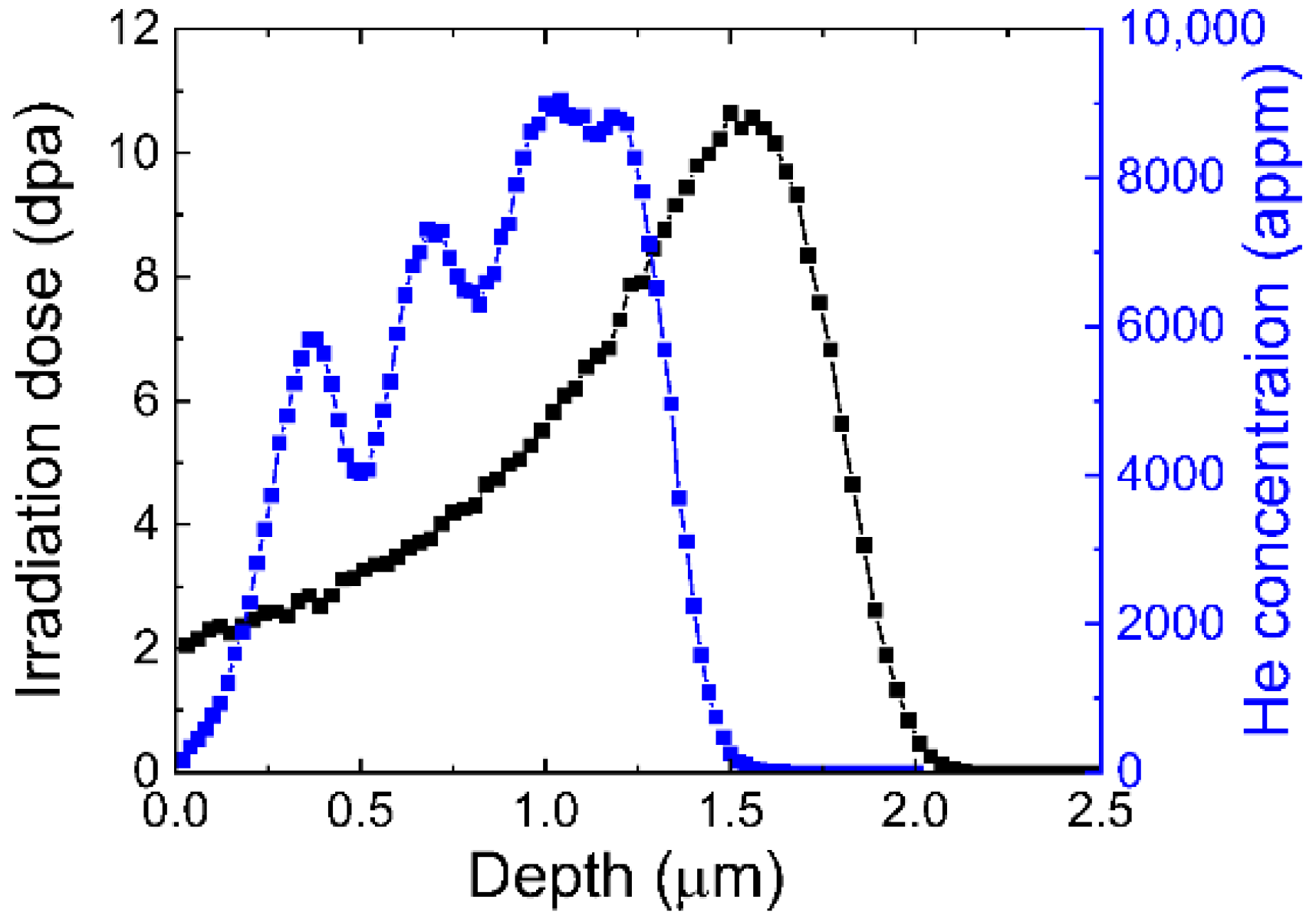
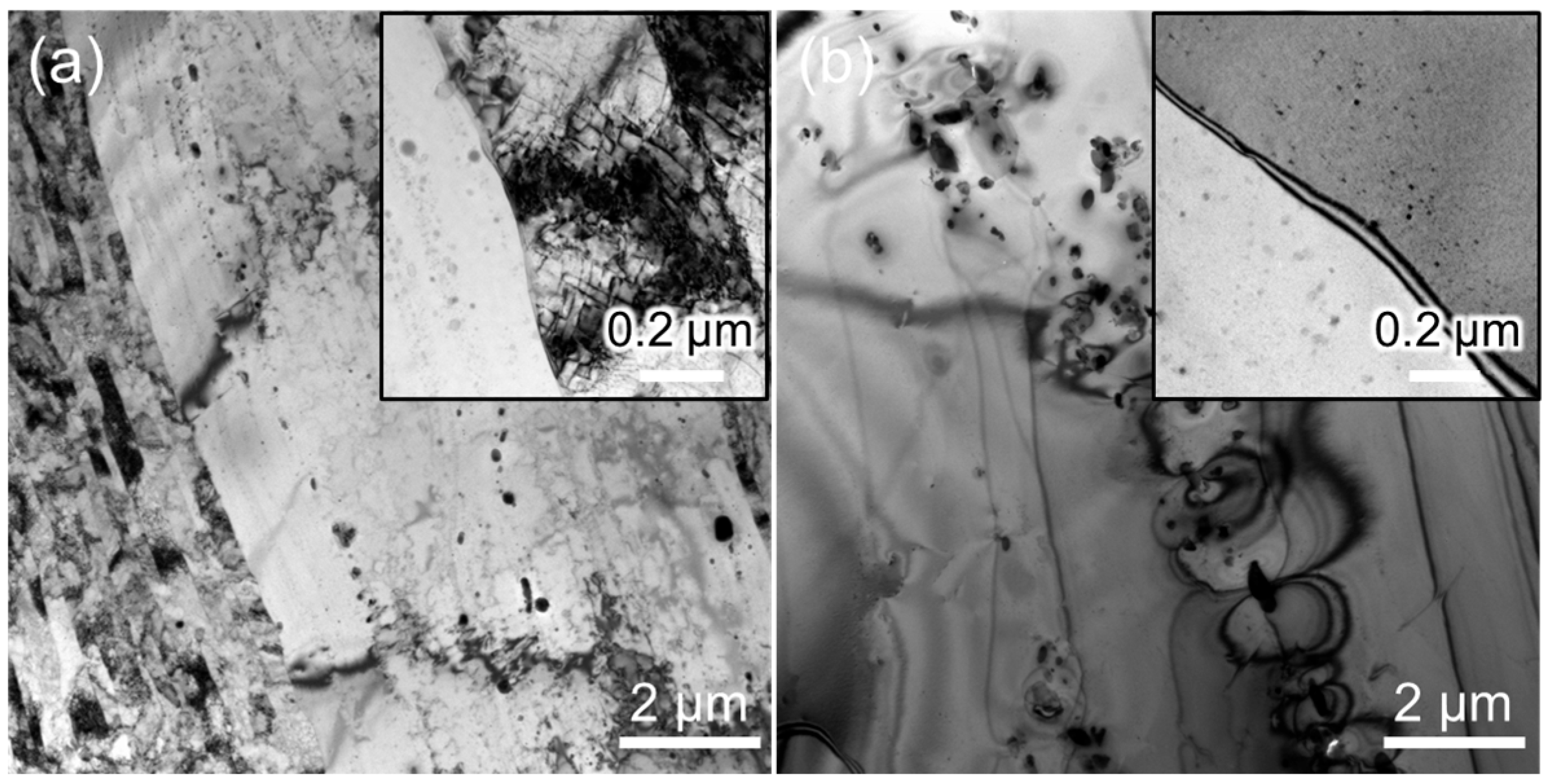
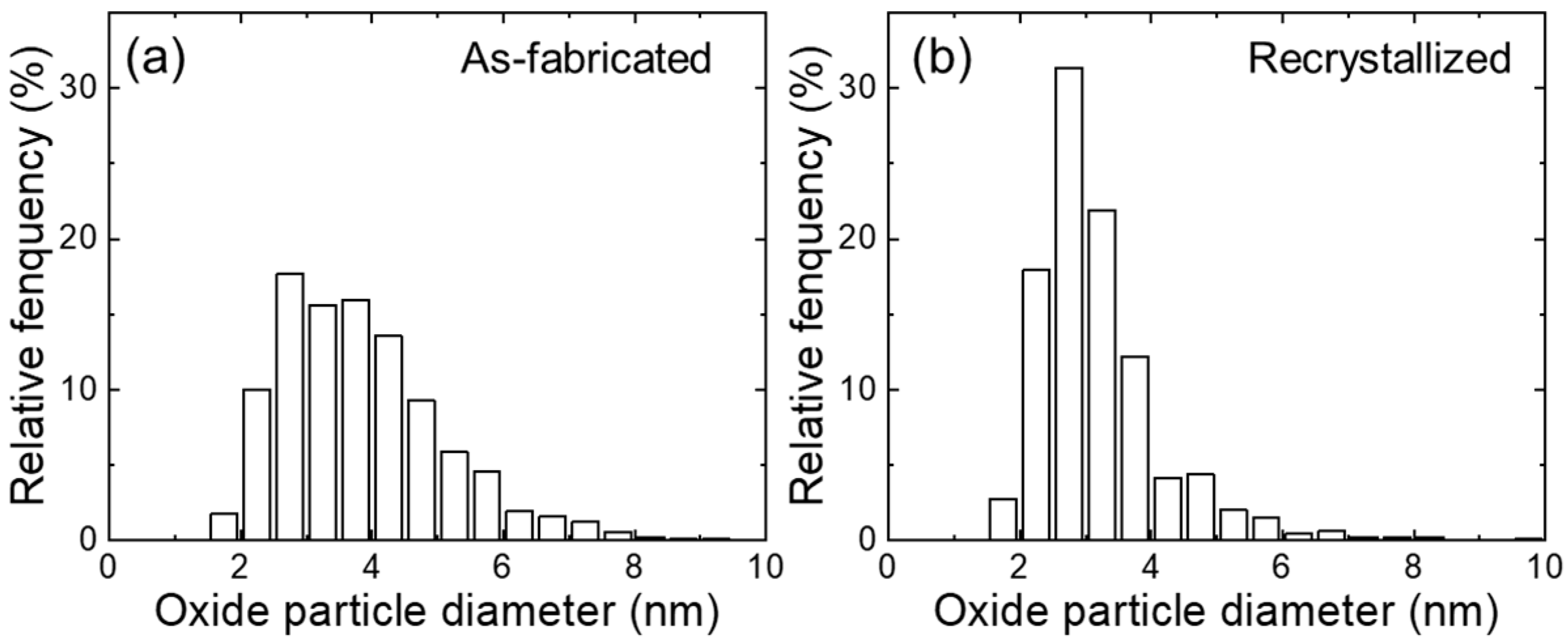
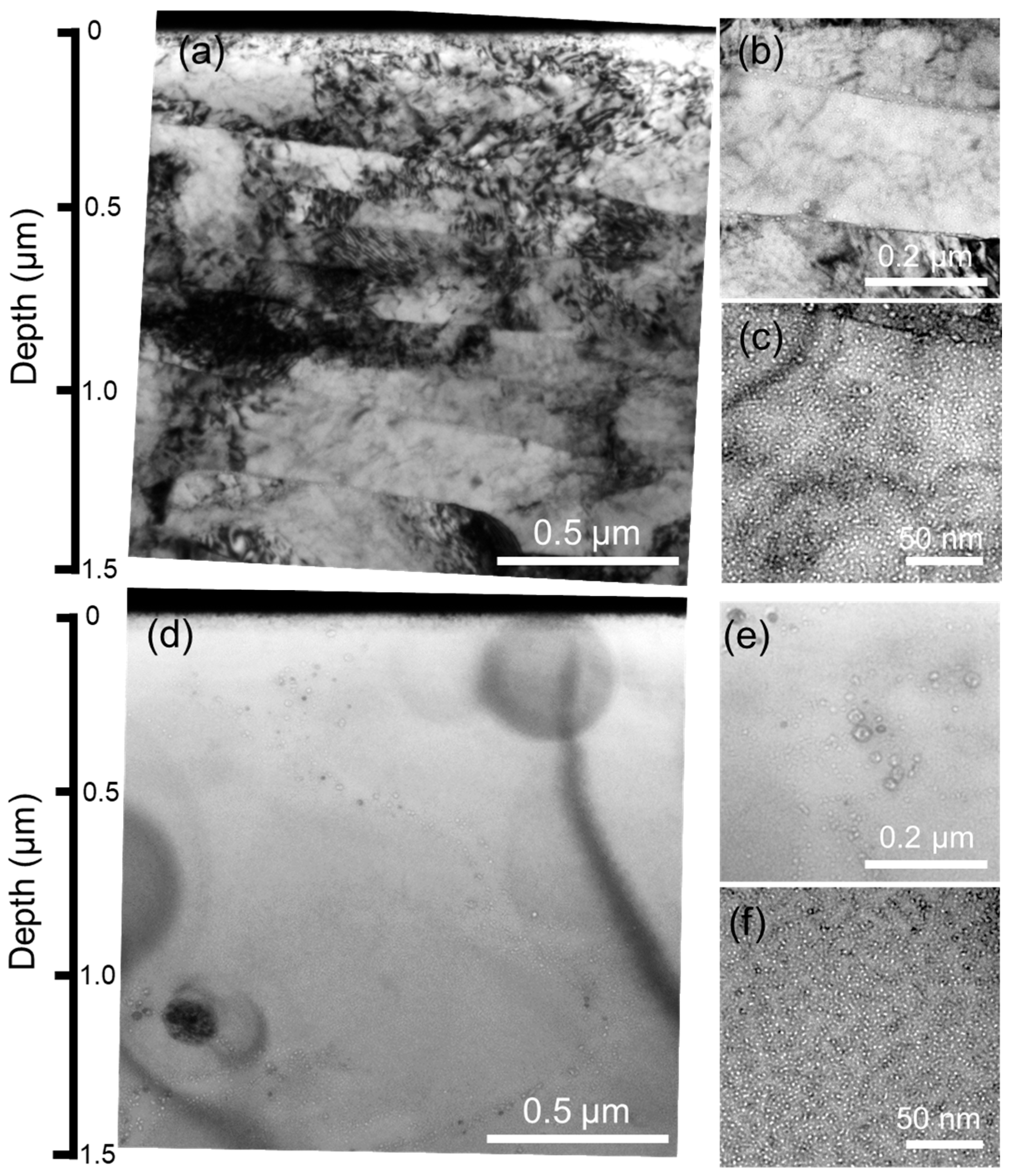
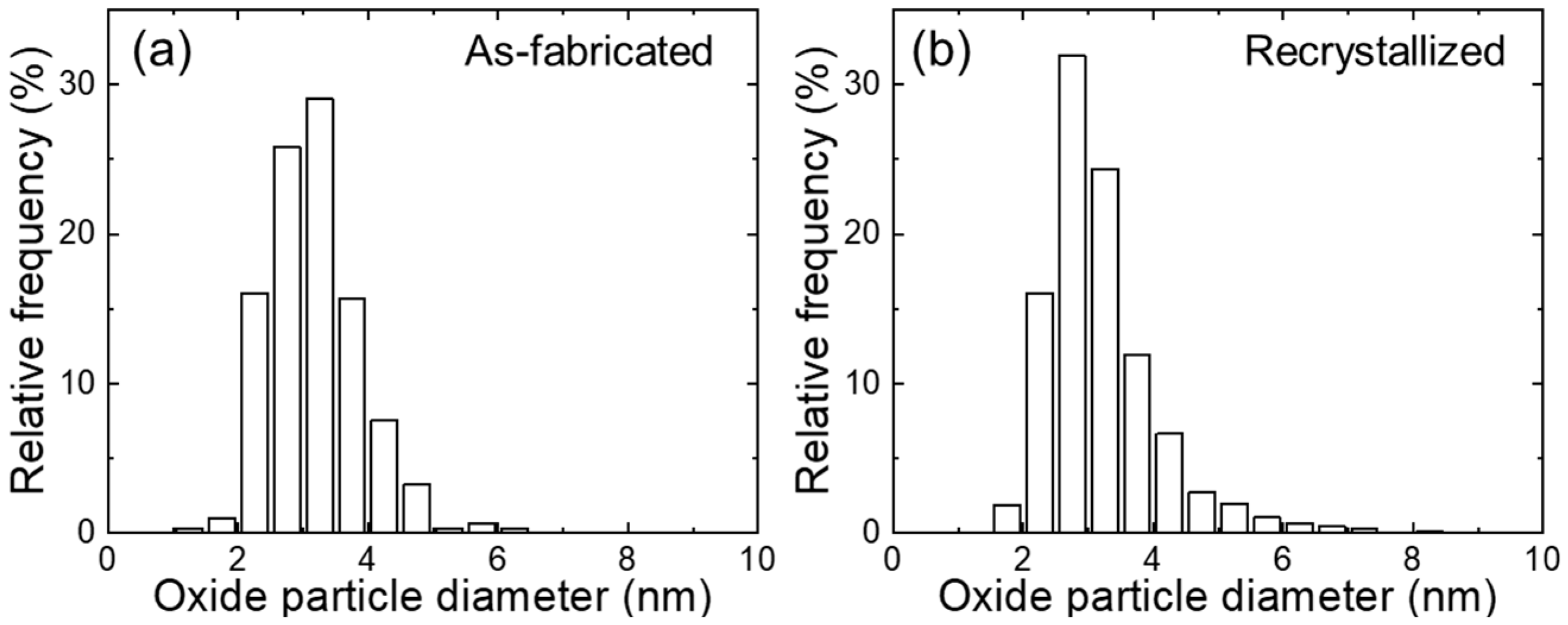
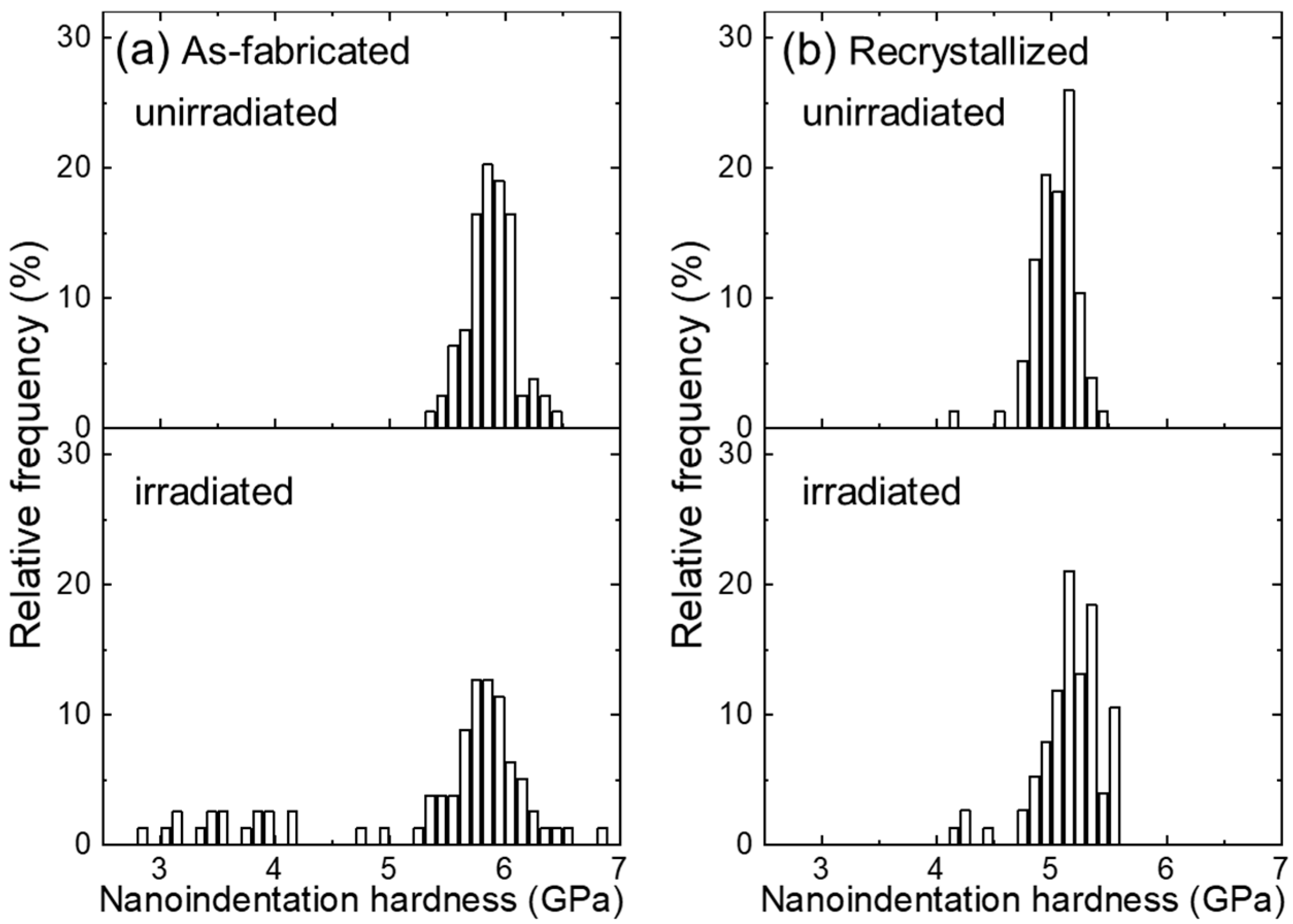
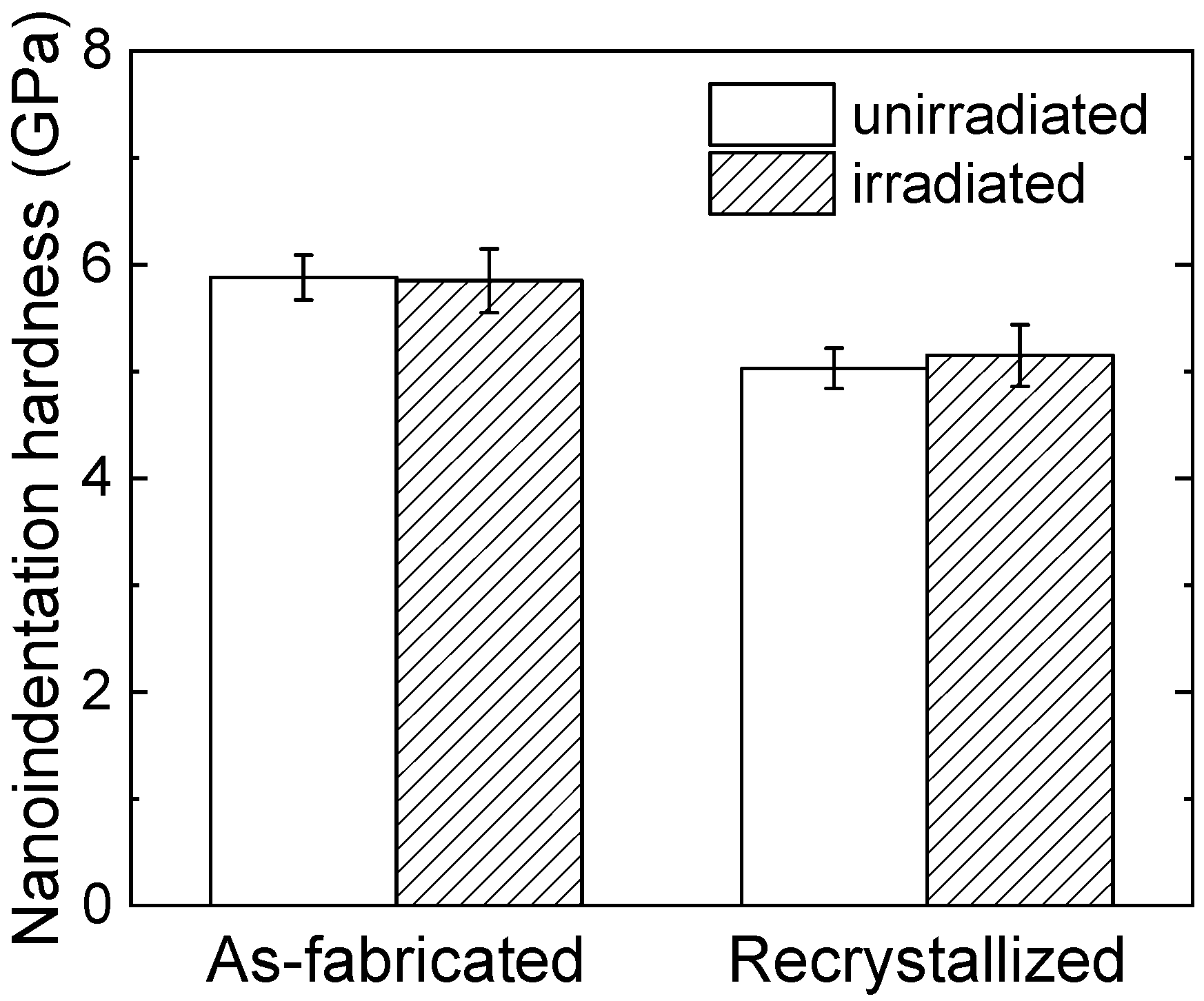
Disclaimer/Publisher’s Note: The statements, opinions and data contained in all publications are solely those of the individual author(s) and contributor(s) and not of MDPI and/or the editor(s). MDPI and/or the editor(s) disclaim responsibility for any injury to people or property resulting from any ideas, methods, instructions or products referred to in the content. |
© 2025 by the authors. Licensee MDPI, Basel, Switzerland. This article is an open access article distributed under the terms and conditions of the Creative Commons Attribution (CC BY) license (https://creativecommons.org/licenses/by/4.0/).
Share and Cite
Shen, J.; Yabuuchi, K. Irradiation Effects of As-Fabricated and Recrystallized 12Cr ODS Steel Under Dual-Ion Beam at 973 K. Materials 2025, 18, 3246. https://doi.org/10.3390/ma18143246
Shen J, Yabuuchi K. Irradiation Effects of As-Fabricated and Recrystallized 12Cr ODS Steel Under Dual-Ion Beam at 973 K. Materials. 2025; 18(14):3246. https://doi.org/10.3390/ma18143246
Chicago/Turabian StyleShen, Jingjie, and Kiyohiro Yabuuchi. 2025. "Irradiation Effects of As-Fabricated and Recrystallized 12Cr ODS Steel Under Dual-Ion Beam at 973 K" Materials 18, no. 14: 3246. https://doi.org/10.3390/ma18143246
APA StyleShen, J., & Yabuuchi, K. (2025). Irradiation Effects of As-Fabricated and Recrystallized 12Cr ODS Steel Under Dual-Ion Beam at 973 K. Materials, 18(14), 3246. https://doi.org/10.3390/ma18143246




